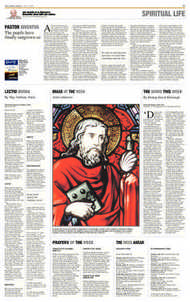Page 18, 17th July 2009
Page 18

Report an error
Noticed an error on this page?If you've noticed an error in this article please click here to report it.
Tags
Share
Related articles
Personality Of A Saint
Blue-blooded Evangelisers Of The Dark Ages
Bishop Explains Rome Decree On Saints
St David Of Wales (march 1)
What Is An Con?
SAINT OF THE WEEK
St Kenelm (July 17)
In the canons of sanctity, Kenelm, or Cynehelm, appears as a royal child murdered in the early ninth century.
According to the earliest surviving account, from the mid-11th century, he was the son of King Cenwulf of Mercia, whom he succeeded aged seven. His elevation, however, excited the jealousy of his sister Cwenthryth, who suborned the royal tutor Aescberht to kill him.
The foul deed was accomplished when Aescberht decapitated Kenelm while out hunting. Subsequently the boy’s corpse was buried at Clent, near Stourbridge.
Cwenthryth thus realised her ambition and succeeded to the throne. In Rome, however, Leo III (Pope from 795 to 816) received a parchment dropped by a dove. This document described, in Anglo-Saxon, how Kenelm’s body lay under a thorn tree at Clent.
Leo passed this intelligence on to the English episcopate. Soon afterwards the child’s remains were unearthed and reburied at Winchcombe in Gloucester shire, where a Benedictine Abbey had recently been founded.
As the funeral procession approached the abbey church, we are told, Cwenthryth stood at a window reciting the psalter backwards, by way of a curse.
Her malediction, however, afflicted none but herself, for both her eyes, dropped out on to her book. The bloodstained psalter, apparently, was later displayed at Winchcombe.
One of the many problems with this history is that there never was a king of Mercia called Kenelm. The Anglo-Saxon Chronicle reports that in 819 (actually it was 821) King Cenwulf was succeeded neither by Kenelm nor by Cwenthryth, but by his brother Ceolwulf.
There are a number of Mercian charters between 803 and 811, in which a Cynehelm, designated princeps or dux, appears as a witness. Even in 803, however, this Cynehelm must have been far older than seven. Evidently he cannot have been the child martyr of 821. Tradition is clear, though, that St Kenelm was associated with the Mercian monarchy. An early 11thcentury list of saints’ burial places describes him as cynebearn, or royal child.
His feast day, July 17, first appears in calendars as early as the third quarter of the 10th century. It has been suggested that Kenelm’s cult was promoted by Oswald, bishop of Worcester from 961 to 972, who restored the monastery at Winchcombe.
At all events, Kenelm’s legend flourished, and Winchcombe became one of the most important Benedictine abbeys in England. In the 12th century William of Malmesbury reported that there was no place in the country to which pilgrims travelled more frequently than Winchcombe, on Kenelm’s feast day.
There are seven church dedications to Kenelm in England, including those at Kenelmstow, near Clent, and Minster Lovell in Oxfordshire. The child saint also appears in Chaucer’s Nun’s Priest’s Tale, failing to profit from a dream which predicts his murder.
blog comments powered by Disqus





















